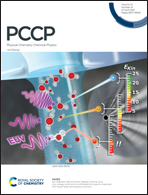On the relaxation dynamics of a double glass-forming antiferroelectric liquid crystal†
Abstract
The relaxation dynamics in the thermodynamic states of the glass-forming antiferroelectric liquid crystal (S)-4′-(1-methyloctyloxycarbonyl) biphenyl-4-yl 4-[7-(2,2,3,3,4,4,4-heptafluorobutoxy) heptyl-1-oxy]-benzoate (3F7HPhH7) was studied by broadband dielectric spectroscopy (BDS). Two glass transitions were found at Tg,1 = 259 K and Tg,2 = 239 K, which were associated with the freezing of anti-phase motions and reorientation around the long molecular axis in the antiferroelectric SmCA* phase, respectively. The low temperature α2-relaxation process shows a Vogel–Fulcher–Tammann (VFT)-type temperature dependence of its structural relaxation time τ(T). The two secondary β- and γ-relaxation modes ascribed to the intramolecular motions observed in the glassy state show Arrhenius behaviour of τ(T). Analysing the band shifts and the oscillator strengths of specific IR absorption bands and their temperature dependencies enables comparing them with the dielectrically determined relaxation dynamics. The kinetics of the isothermal cold crystallization in the temperature range between Tg,1 and Tg,2 was studied in detail using the Avrami and Avrami–Avramow models. This process depends primarily on the diffusion rate and the activation energy is equal to 132 kJ mol−1. The obtained values of the Avrami exponent nA suggest that the crystal growth is three-dimensional.



 Please wait while we load your content...
Please wait while we load your content...